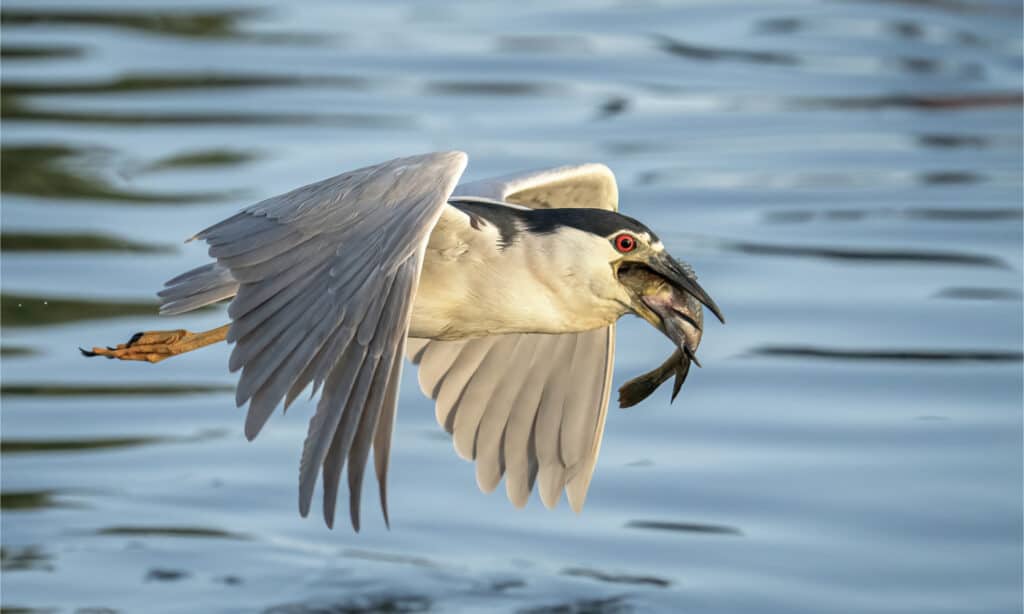Night Heron
.jumbotron {
background-image: url(“https://a-z-animals.com/media/2022/05/Nycticorax-nycticorax-400×300.jpg”);
}
}
@media only screen and (min-width: 641px) and (max-width: 920px) {
.jumbotron {
background-image: url(“https://a-z-animals.com/media/2022/05/Nycticorax-nycticorax-470×370.jpg”);
}
}
@media only screen and (min-width: 921px) {
.jumbotron {
background-image: url(“https://a-z-animals.com/media/2022/05/Nycticorax-nycticorax.jpg”);
}
}
Night Heron
Nycticorax nycticorax
When they feel threatened juvenile night herons vomit their stomach contents.
Night Heron Scientific Classification
- Kingdom
- Animalia
- Phylum
- Chordata
- Class
- Aves
- Order
- Pelecaniformes
- Family
- Ardeidae
- Genus
- Nycticorax
- Scientific Name
- Nycticorax nycticorax
Read our Complete Guide to Classification of Animals.
Night Heron Conservation Status
Night Heron Facts
- Prey
- Fish, frogs, insects
- Fun Fact
- When they feel threatened juvenile night herons vomit their stomach contents.
- Estimated Population Size
- 570,000 – 3,730,000
- Biggest Threat
- Habitat destruction
- Most Distinctive Feature
- Crown of feathers
- Other Name(s)
- Heron
- Wingspan
- 45-47 inches
- Incubation Period
- 21-22 days
- Diet
- Omnivore
- Lifestyle
-
- Nocturnal
- Type
- Bird
- Common Name
- Night heron
- Number Of Species
- 1
- Nesting Location
- In trees or in reed beds on the ground
- Migratory
- 1
This post may contain affiliate links to our partners like Chewy, Amazon, and others. Purchasing through these helps us further the A-Z Animals mission to educate about the world’s species..

Spiders that fly! Fish that walk! And 1000+ more incredible animals. Discover them all for FREE
.photo-gallery {
–margin: 0px auto 0px;
–padding: 0px 0px 0px 0px;
}
.gallery-link {
background-image: url(“https://a-z-animals.com/media/2022/05/Nycticorax-nycticorax-1024×614.jpg”);
background-repeat: no-repeat;
background-size: cover;
background-position: center;
height: 500px;
justify-content: center;
text-align: center;
align-items: center;
display: flex;
border: 2px solid #000;
}
.gallery-link img {
height: 50%;
}
@media only screen and (max-width: 768px) {
.gallery-link {
height: 300px !important;
}
}
View all of the Night Heron images!
Night herons have a wingspan of 45 to 47 inches.
Night herons can be seen walking on the shorelines of marshes and wetlands in search of fish, frogs, and insects to eat. This bird is known for its long, thin legs, intense gaze, and crown of feathers. The territory of various types of night herons extends over six continents. Its call has been compared to the croaking sound made by a raven.
3 Night Heron Amazing Facts
- While adult night herons have few predators, their eggs are eaten by snakes and raccoons
- It can reach a flying speed of 35mph
- Juvenile night herons are known to vomit their lunch when threatened
Where to Find Night Heron
Where do you find night herons? The answer: Almost everywhere! Night herons are seen on six continents including North America, South America, Asia, Europe, Africa, and Australia. They live in temperate and tropical climates. Their habitats include wetlands, marshes, and mangroves where they can search in the water and on land for food.
button.pulse {
transform: scale(1); animation: pulse 2s infinite;
box-shadow: 0 0 0 0 rgba(11, 247, 25, 1);
}
@keyframes pulse {
0% { transform: scale(0.90); box-shadow: 0 0 0 0 rgba(11, 247, 25, 0.5); }
60% { transform: scale(1); box-shadow: 0 0 0 15px rgba(11, 247, 25, 0); }
100% { transform: scale(0.90); box-shadow: 0 0 0 0 rgba(11, 247, 25, 0); }
}
Take one look at this bird’s name and you know it’s most active during the night. So, if you want to see a night heron, it’s best to grab a flashlight before visiting a marsh or mangrove.
Spring and late summer are the breeding seasons of this bird. This is when they’re especially visible as they build nests in the trees or on the ground.
These birds live in dozens of countries across the above continents. Some of these countries include:
- Argentina
- United States
- Canada
- Ireland
- Sweden
- Turkey
- Japan
- Madagascar
- South Africa
- Micronesia
Night Heron Nests
The male night heron searches for twigs and sticks on the ground. When he finds a sturdy stick or twig, he gives it to the female of the pair who uses it to build the nest. The nest may be in a tree or on the ground in a sheltered area among a gathering of tall weeds.
The nest of a night heron measures from 12 to 18 inches in width and can be from eight to 12 inches tall. The structure has sticks and twigs of different sizes sticking out at every angle. But there’s ample space to accommodate three to eight two-inch-long eggs.
Scientific Name
Nycticorax nycticorax is the scientific name of the black-crowned night heron. The Latin word nycticorax means night raven. Though the night heron is not related to the night raven, there are some reasons behind the scientific name. The night heron is active at night and this bird’s call sounds similar to a raven’s call: “Croak, croak!”
It’s in the Ardeidae family and in the Aves class.
The black-crowned night heron also called the black-capped night heron, is one species of this bird. Others include:
- Yellow-crowned night heron or yellow-crested heron (Nyctanassa violacea)
- Nankeen night heron (Nycticorax caledonicus)
Appearance and Behavior
The various types of night herons differ a bit in appearance. The black-crowned night heron or black-capped night heron has white feathers on its breast along with greyish black wings. It has a black crown or cap of feathers atop its head. Alternatively, a yellow-crowned night heron has gray, almost purple feathers on its breast and wings. This bird has a stripe of white feathers near each eye and yellow feathers that stick up on its head. Its sometimes called the yellow-crested night heron because its long crest of yellow feathers extends over the back of its head.
Juvenile black-crowned or black-capped night herons have brown feathers with some white spots mixed in. Its beak is not yet deep black like an adult night heron’s beak.
An adult night heron has a long, pointed beak it uses to grasp fish, insects, and other prey. It walks on its long, thin legs through the water and grasps tree branches with its four sharp claws.
This bird is 23 to 26 inches long and weighs 26 to 36 ounces. Its wingspan is 45 to 47 inches.
Along with using its long, pointed beak to find food, the night heron uses it to defend itself. Luckily, its habitat high up in the treetops helps it to avoid many predators.

Wirestock Creators/Shutterstock.com
Migration and Timing
While some types of night herons live in the same area year-round others migrate to warmer places for the winter months. As an example, in September or October the black-crowned night herons living in Massachusetts fly south down the coastline to Florida. Black-crowned night herons living in Alberta, Canada fly south to spend the winter in Mexico. Some of these birds have a migration route running beside the Mississippi River system.
Diet
All types of night herons including black-crowned and yellow-crested varieties are carnivores. They hunt for food at night by standing perfectly still in or near the water until a fish swims close by. Within seconds, the bird grabs it and swallows it!
What does a night heron eat?
Frogs, fish, and insects are all prey in the diet of night herons.
Predators and Threats
What eats night herons?
Adult night herons spend time high up in the trees which makes them less vulnerable to predators. But, they do have some including owls and foxes.
Hatchling and juvenile night herons are more likely to be preyed upon by foxes and owls because they are smaller and not as strong as adult birds. Furthermore, raccoons and snakes have been known to steal night heron eggs out of a nest to eat them.
Habitat destruction is another threat to adult night herons. Drainage of the wetlands has affected the population of this bird. Their population has also been affected by pesticides in the insects they eat.
Steps have been taken to help night herons including setting up protected areas where they can breed. The IUCN Red List of Threatened Species categorizes it as Least Concern, but with decreasing numbers.
Reproduction, Babies, and Lifespan
Male and female night herons are monogamous and both parents take care of the eggs. Female night herons lay three to eight eggs in late spring or early summer. After 21 or 22 days, the eggs hatch. The chicks leave the nest at just two weeks old. The chicks grow quickly into juvenile birds. They remain in the nesting area until they can live independently at six to seven weeks old. These birds are sexually mature at the age of two or three years.
The lifespan of a night heron is 10 to 15 years.
Population
The worldwide population of the night heron is 570,000 to 3,730,000 birds. Though their numbers are reportedly decreasing, the night heron is of Least Concern to conservationists.
View all 39 animals that start with N
Night Heron FAQs (Frequently Asked Questions)
Does a night heron migrate?
Some night herons migrate to warmer climates while others are residents in certain areas year-round.
How many eggs does a night heron lay?
A female lays three to eight eggs.
How fast does a night heron fly?
This bird can fly 35mph and sometimes faster.
What is a night heron’s wingspan?
Its wingspan is 45 to 47 inches.
When do night heron’s leave the nest?
The chicks leave the nest at two weeks old but remain in the area until they can survive independently at around six or seven weeks of age.
Why is a night heron called a night heron?
It is called a night heron because it’s active at night and sleeps during the day.
It is called a night heron because it’s active at night and sleeps during the day.
These birds are found in Africa, Australia, North America, South America, Europe, and Asia. They occupy a wetland, mangrove, or marsh habitat.
What does a night heron eat?
These birds eat insects, frogs, fish, and snails.
Sources
- EOL, Available here: https://eol.org/pages/45511340
- Maryland Zoo, Available here: https://www.marylandzoo.org/animal/black-crowned-night-heron/
- IUCN Red List, Available here: https://www.iucnredlist.org/species/22697211/155515762
- NHP TV, Available here: http://www.nhptv.org/natureworks/yellowcrownednighttheron.htm
- Wikipedia, Available here: https://en.wikipedia.org/wiki/Yellow-crowned_night_heron
- Oceanwide Expeditions, Available here: https://oceanwide-expeditions.com/to-do/wildlife/black-crowned-night-heron
- National Zoo, Available here: https://nationalzoo.si.edu/migratory-birds/species-profile-black-crowned-night-heron
















